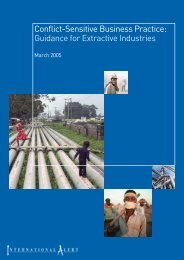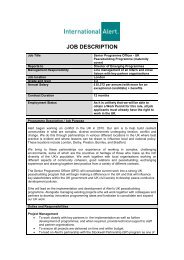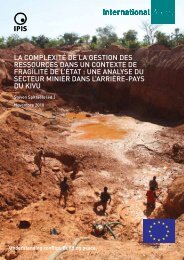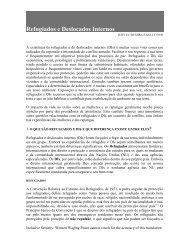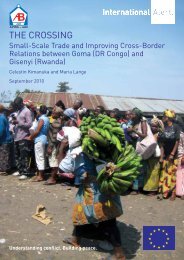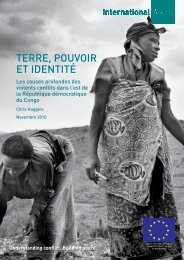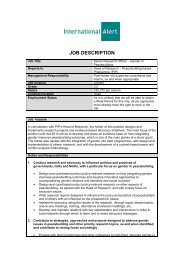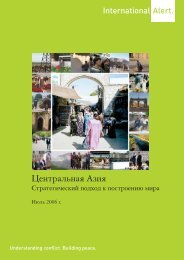The complexiTy of resource governance in a conTexT of sTaTe ... - Ipis
The complexiTy of resource governance in a conTexT of sTaTe ... - Ipis
The complexiTy of resource governance in a conTexT of sTaTe ... - Ipis
You also want an ePaper? Increase the reach of your titles
YUMPU automatically turns print PDFs into web optimized ePapers that Google loves.
16 International Alert<br />
Artisanal exploitation cont<strong>in</strong>ues, though production and export volumes are far from the levels <strong>of</strong><br />
the <strong>in</strong>dustrial era. In 2009, reported production at the renamed Congo-Eta<strong>in</strong> sites was a mere 900<br />
tonnes, 16 though actual volumes may be higher. <strong>The</strong> most important Congo-Eta<strong>in</strong> sites, where<br />
m<strong>in</strong><strong>in</strong>g still takes place, are situated <strong>in</strong> and around the town <strong>of</strong> Manono. Artisanal m<strong>in</strong>ers even<br />
dig for cassiterite on the site <strong>of</strong> the former smelt<strong>in</strong>g plant.<br />
To the north lies Katonge, a large coltan m<strong>in</strong>e operated by more than 500 artisanal m<strong>in</strong>ers.<br />
Although it lies <strong>in</strong> the territory <strong>of</strong> Manono, Katonge is close to the border with Nyunzu and its<br />
m<strong>in</strong>eral trade is therefore oriented towards Kalemie and the Lake Tanganyika coast.<br />
Malemba Nkulu<br />
Cassiterite is the m<strong>in</strong>eral <strong>of</strong> choice <strong>in</strong> the territory <strong>of</strong> Malemba Nkulu, which is more productive<br />
than its neighbour, Manono. <strong>The</strong> m<strong>in</strong><strong>in</strong>g potential <strong>of</strong> Malemba Nkulu is <strong>of</strong>ten underestimated for<br />
historical and geographic reasons. When Géom<strong>in</strong>es was still operational, it processed cassiterite from<br />
Malemba Nkulu, but, unlike Manono, all exploitation <strong>in</strong> Malemba Nkulu was artisanal. Because<br />
Géom<strong>in</strong>es/Congo-Eta<strong>in</strong>’s ma<strong>in</strong> <strong>in</strong>stallations were located around Manono, it became known as the<br />
t<strong>in</strong>-m<strong>in</strong><strong>in</strong>g centre. Nowadays, all m<strong>in</strong><strong>in</strong>g is artisanal but, as Malemba Nkulu is one <strong>of</strong> the most<br />
isolated territories <strong>in</strong> the prov<strong>in</strong>ce, Manono still serves as the regional centre for trade and transport<br />
– obscur<strong>in</strong>g the fact that the majority <strong>of</strong> traded cassiterite orig<strong>in</strong>ates from Malemba Nkulu.<br />
Malemba Nkulu territory is divided by the Congo River and the western end is <strong>of</strong>ten referred<br />
to as the “left bank” and the eastern as the “right bank”. <strong>The</strong> latter depends on Manono for<br />
trade. <strong>The</strong> most important m<strong>in</strong><strong>in</strong>g site is Kanya m<strong>in</strong>e, near Kanunka village. Activity dramatically<br />
decreased <strong>in</strong> 2010 because <strong>of</strong> flood<strong>in</strong>g but now appears on the rise aga<strong>in</strong>. Also worth mention<strong>in</strong>g<br />
are the m<strong>in</strong><strong>in</strong>g sites near Ngoya.<br />
<strong>The</strong>re are a few cassiterite m<strong>in</strong>es on the left bank, each exploited by several hundred m<strong>in</strong>ers.<br />
Kabala m<strong>in</strong>e is close to the town <strong>of</strong> Malemba. Slightly further is the village <strong>of</strong> Nseya, where the<br />
M<strong>in</strong><strong>in</strong>g M<strong>in</strong>eral Resources (MMR) comptoir has a presence, and which is supplied by a number<br />
<strong>of</strong> m<strong>in</strong>es <strong>in</strong> the vic<strong>in</strong>ity.<br />
1.3 General analysis <strong>of</strong> the m<strong>in</strong>eral trade<br />
Kivu traders<br />
Until late 2009, traders orig<strong>in</strong>at<strong>in</strong>g from, and operat<strong>in</strong>g through, North and South Kivu prov<strong>in</strong>ces<br />
dom<strong>in</strong>ated the m<strong>in</strong>erals trade from Northern Katanga. Bus<strong>in</strong>essmen from the Bashi and Nande<br />
ethnic groups bought cassiterite and coltan from local m<strong>in</strong>ers, and transported it by air or road to<br />
Goma or Bukavu. <strong>The</strong>y comb<strong>in</strong>ed these shipments with deliveries <strong>of</strong> consumer goods and food,<br />
provid<strong>in</strong>g Katangese communities with products that were previously hard to f<strong>in</strong>d, while mak<strong>in</strong>g<br />
additional pr<strong>of</strong>its.<br />
<strong>The</strong> dom<strong>in</strong>ant position <strong>of</strong> Kivu traders is reflected <strong>in</strong> the statistics <strong>of</strong> the Division des M<strong>in</strong>es <strong>in</strong><br />
Kalemie, which recorded the shipp<strong>in</strong>g <strong>of</strong> 181 tonnes <strong>of</strong> coltan and 900 tonnes <strong>of</strong> cassiterite from<br />
or through Tanganyika district to the Kivu prov<strong>in</strong>ces between January–October 2009. 17 Similarly,<br />
over 90 percent <strong>of</strong> cassiterite from Lomami district was transported through Kongolo to Bukavu<br />
from June–October 2009. 18 It is impossible to check if these numbers correspond to statistics<br />
at the dest<strong>in</strong>ation (see Box 1). <strong>The</strong> 2008 annual report <strong>of</strong> the Division des M<strong>in</strong>es <strong>in</strong> South Kivu<br />
16 Division des M<strong>in</strong>es Katanga, Rapport Annuel 2009, p.48.<br />
17 Divison des M<strong>in</strong>es, District du Tanganika, Rapport Annuel 2009. <strong>The</strong> same document reports that <strong>in</strong> August 2009 alone air companies <strong>in</strong><br />
Kongolo flew 126.2 tons <strong>of</strong> cassiterite orig<strong>in</strong>at<strong>in</strong>g from Manono to North and South Kivu. This figure does not <strong>in</strong>clude smuggled shipments.<br />
18 Accord<strong>in</strong>g to the Manono m<strong>in</strong><strong>in</strong>g adm<strong>in</strong>istration, “frequent flyers” to Bukavu <strong>in</strong>cluded Agence BMA, C<strong>of</strong>fret Express, Maison Mississikano,<br />
Mbusa Makalikali, Stella Via, Agence Luhusa.





